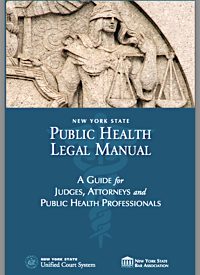
When Fox News’ conservative pundit Glenn Beck or The John Birch Society warns of impending doom as a result of civil unrest, an underground Marxist movement, and the Cloward and Piven plot to collapse the economy, they are touted as fearmongers by the Left and the mainstream media. One wonders what those groups would have to say about New York’s recently released apocalypse guide.
Entitled New York State Public Health Legal Manual, the 102-page guide instructs its readers on what to do in the case of a cataclysmic disaster. The New York Times writes:
Quarantines. The closing of businesses. Mass evacuations. Warrantless searches of homes. The slaughter of infected animals and the seizing of property. When laws can be suspended and whether infectious people can be isolated against their will or subjected to mandatory treatment. It is all there, in dry legalese, in the manual, published by the state court system and the state bar association.
The manual provides a set of instructions for how judges and lawyers would handle such grim scenarios in the face of terrorist attacks, chemical or radiological warfare, or a crisis of any other variety.
Its preface, which includes separate forewords from New York State’s chief judge Jonathan Lippman and the bar association’s president Stephen Younger, reads:
In today’s world, we face many natural and man-made catastrophic threats, including the very real possibility of a global influenza outbreak or other public health emergency that could infect millions of people. While it is impossible to predict the timing or severity of the next public health emergency, our government has a responsibility to anticipate and prepare for such events. An important element of this planning process is advance coordination between public health authorities and our judicial and legal systems. The major actors in any public health crisis must understand the governing laws ahead of time, and must know what their respective legal roles and responsibilities are. What is the scope of the government’s emergency and police powers? When may these be invoked, and by which officials? What are the rights of people who may be quarantined or isolated by government and public health officials?
These questions must be researched and answered now — not in the midst of an emergency — so that the responsible authorities have a readymade resource to help them make quick, effective decisions that protect the public interest. This New York State Public Health Legal Manual is designed to serve this purpose. It will be an absolutely essential tool in guiding us through the effective management of future public health disasters. I am pleased that the New York State Unified Court System was able to play a key role in this historic collaboration along with the New York State Bar Association, the New York State Department of Health, and the New York City Department of Health and Mental Hygiene. I thank each of these organizations for their invaluable cooperation and contributions.
Much of the guide focuses on the application (and possible suspension) of the Constitution to crises such as those that necessitate quarantine or vaccinations, whether they are voluntary or involuntary.
The manual ultimately reiterates the authority of the state to declare a state of emergency, which allows it to then impose curfews, quarantine wide areas, restrict public gatherings, and close businesses.
The Times explains:
The manual provides a catalog of potential terrorism nightmares, like smallpox, anthrax or botulism episodes. It notes that courts have recognized far more rights over the past century or so than existed at the time of Typhoid Mary’s troubles. It details procedures for assuring that people affected by emergency rules get hearings and lawyers. It mentions that in the event of an attack, officials can control traffic, communications and utilities. If they expect an attack, it says, they can compel mass evacuations.
The manual also indicates that individuals can be mandated to shelter any victims of a crisis, and contends that “violations of individual property rights, if actionable, would generally be sorted out after the need for such actions has ended.”
While much of the language appears to be unassuming and harmless, it invokes apocalyptic scenarios that city officials would be forced to address.
For example, the manual carefully sidesteps specific references to court officials themselves being among those harmed or killed in the scenarios when it says, “If there is a shortage of court personnel, administrators can take a number of steps to keep the courts operating.”
The guide reports that the outbreak of a contagious disease may require those in a courtroom to wear respirators, conjuring up fearful images for readers.
Ronald Younkins, the chief of operations for the state court system, asserts that the guide is similar to other steps taken by the New York courts to prepare for emergencies, including increasing the quantity of latex gloves and respirators on hand. He adds, however, “It is a very grim read. This is for potentially very grim situations in which difficult decisions have to be made.”
An electronic copy of the guide can be found on the website of the court system, but bound copies are also available for sale at a cost of $18 each.
In the same vein of preparedness, the Wisconsin National Guard has put in place a number of contingency plans on how to deal with specific types of disasters. Lt. Col. Jackie Guthrie, a spokesman for the state’s National Guard, observes, “There is a contingency plan for every state emergency.”
Brigadier General Don Dunbar, commander of the Wisconsin National Guard, asserts, “We are always ready to provide citizen soldiers and airmen anywhere, at any time, to support community, state and federal missions. This is the mission of the National Guard.”
Perhaps some states are finally heeding the warnings of the experts — or perhaps they are simply fearmongers as well.




